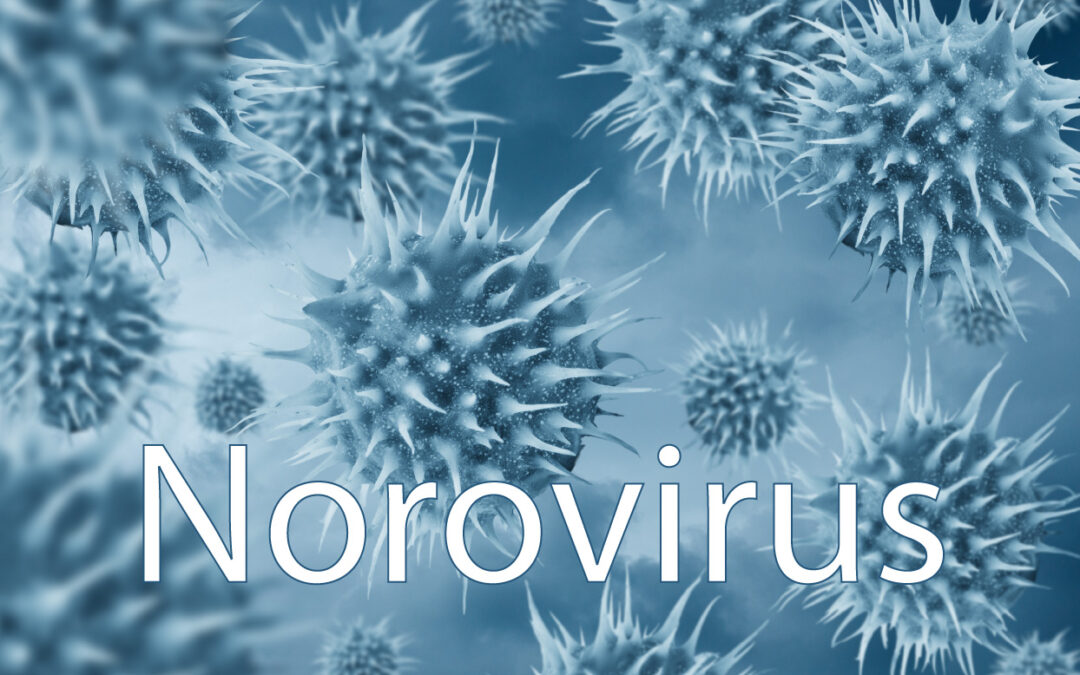Norovirus was first reported in 1929 when it was singled out as the cause of a winter vomiting disease. In 1968, the virus was named Norwalk virus, and many of its symptoms and incubation times were described as part of investigations of a large outbreak. In the 1990s, scientists started to better understand the virus’s genes and proteins and classified the Norwalk virus as part of a larger group of viruses causing similar symptoms. The viruses in this group are now known as Noroviruses.
Noroviruses are the leading cause of epidemic acute gastroenteritis, particularly in close settings like hospitals, schools, and cruise ships. Common symptoms are vomiting and diarrhea, caused by inflammation of the stomach and intestine. In children, elderly people, and immunocompromised individuals, the disease can lead to more serious problems, often related to dehydration.
The virus is highly contagious and spreads easily through contaminated food, water, and surfaces. Precautions to avoid the initial contamination and spread include hand washing (hand sanitizers don’t work!), cleaning fruit and vegetables, only drinking water and consuming raw food from reliable sources, and thoroughly disinfecting surfaces if they have been in contact with infected people.
The virus:
Noroviruses are non-enveloped viruses. Their structure consists of just two major elements: their genetic material (positive single-stranded RNA) and the protein capsid that surrounds it.
Their entry into the host’s cells is a multi-step process involving cell attachment by binding to cell surface glycans and soluble cofactors, including histo-blood group antigens (HBGAs), bile acids, sialic acid, and divalent cations. Attachment is followed by receptor binding (different for different noroviruses); virus internalisation by endocytosis; and cell membrane penetration triggered by the capsid protein, which leads to uncoating and to the viral RNA being exposed to the cell cytoplasm. After uncoating, the replication process starts, culminating in virus particles being released, with the potential to cause serious illness.
The Norovirus genus is divided into seven genogroups; each group contains different viruses allocated according to the species they might infect. Genogroup I viruses infect humans; Genogroup II viruses infect humans and pigs; Genogroup III viruses infect cows and sheep; Genogroup IV viruses infect humans, cats, and dogs; Genogroup V viruses infect mice; Genogroup VI viruses infect dogs and cats; and Genogroup VII viruses infect dogs. Genogroup II contains the most important strains infecting humans.
It is extremely difficult to grow human norovirus in vitro. Only recently more complex models like stem-cell derived Human Intestinal Enteroid have been successfully used, but the lack of a simpler cellular and animal model for human norovirus has had a negative impact on norovirus research.
For this reason, alternative models have been developed to grow and study the virus in laboratories. The murine norovirus is the best available in vitro model for noroviruses, as it replicates in cell culture and small animals. At VRS, this is the model we use when testing the virucidal properties of materials, fabrics, or disinfection products.
Treatments and vaccines:
There are still no treatments for Noroviruses infections. Instead of targeting the virus, physicians are limited to dealing with the infection’s symptoms and secondary consequences. According to the CDC, the best advice is to drink lots of water to avoid dehydration from diarrhea and vomiting.
Antivirals targeting different stages of the virus life cycle or viral components are currently being studied, but at the moment only Nitazoxanide is anticipated to complete clinical trials.
Many efforts are being made to develop a vaccine against human noroviruses. For instance, Richardson et al have developed a vaccine using virus-like particles, which mimic the structure and composition of viruses but lack the viral genome, making this a safer and cheaper approach to vaccine development. The approach has given encouraging results by inducing antibodies and protecting against a viral challenge in a human clinical study. However, several immune-related issues still constitute major roadblocks.
Firstly, the immunity against norovirus seems to decrease with time after infection, compromising the development of a long-lasting solution. Second, the immunity generated by infection seems to be specific to the infecting virus, with limited to no cross-reactivity across strains. Third, the individual response against norovirus is influenced by genetic components, which can be associated with innate or acquired immunity. In addition, polymorphisms in the FUT2 gene resulting in a non-functional fucosyltransferase enzyme (which in turn compromises the enzyme’s ability to secrete HBGAs in the body fluid) has been identified as one of the main factors determining resistance to infection to certain norovirus infections.
The lack of a complete understanding of these and many other factors are directly related to the difficulties in finding suitable vaccines against noroviruses.
Norovirus as non-enveloped virus model:
Being a non-enveloped virus, murine norovirus is often used as a model not only for human norovirus, but also more in general for non-enveloped viruses. Non-enveloped viruses are typically more resistant to disinfectants and other stresses than enveloped viruses and therefore are often used to determine the virucidal properties of formulations or materials. If your product inactivates murine norovirus, it will likely (but not certainly) also inactivate enveloped viruses.
At VRS, we offer different assays to test the virucidal properties of materials, farbrics, or disinfectants against murine norovirus. If your product achieves antiviral activity against both enveloped and non-enveloped viruses, it is then possible to claim a broad antiviral activity.
Reference:
https://www.cdc.gov/norovirus/index.html
Graziano VR, Wei J, Wilen CB. Norovirus Attachment and Entry. Viruses. 2019;11(6):495. Published 2019 May 30. doi:10.3390/v11060495
Robilotti E, Deresinski S, Pinsky BA. Norovirus. Clin Microbiol Rev. 2015;28(1):134-164. doi:10.1128/CMR.00075-14
Richardson C, Bargatze RF, Goodwin R, Mendelman PM. Norovirus virus-like particle vaccines for the prevention of acute gastroenteritis. Expert Rev Vaccines. 2013;12(2):155-167. doi:10.1586/erv.12.145
https://www.cdc.gov/norovirus/downloads/global-burden-report.pdf
Wobus, C., Thackray, L. and Virgin, H., 2006. Murine Norovirus: a Model System To Study Norovirus Biology and Pathogenesis. Journal of Virology, 80(11), pp.5104-5112.
Atmar RL, Ramani S, Estes MK. Human noroviruses: recent advances in a 50-year history. Curr Opin Infect Dis. 2018;31(5):422-432. doi:10.1097/QCO.0000000000000476




